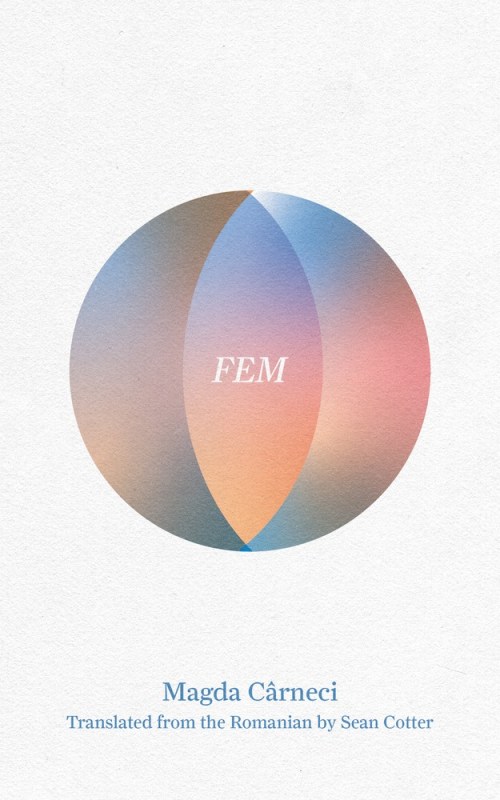[ad_1]
When recalled over morning coffee, intense, meaningful dreams dissolve into confused fragments that escape language and leave even a sympathetic listener out in the cold. But what if a dream could be pinned down with all of its illogically tantalizing details, its particular atmosphere, primal details, shifting scenes, to arrive, finally, at some essential truth? In FEM, Romanian writer Magda Carneci offers up such “trembling images.” They are the visions of an unnamed female narrator who, by her own account, leads an ordinary life, but catalogues the revelations that live inside her. They are “like a second consciousness, wider, vaster, that wants to be born, to appear in the world.”
We learn only the barest outline of this woman’s life: she is young, grew up in a small town, attended summer camp, went to university, lives with her boyfriend. The bulk of the book is dedicated instead to her inner visions—extraordinary images that come to her at ordinary times. The novel begins as a kind of “Portrait of the Visionary as a Young Woman,” with fragmentary childhood memories. Carneci also employs other Joycian techniques, with her narrator switching into third person at times, gaining some distance from surreal events. This is a poet’s novel for readers seeking to be transported by language and image rather than story and character.
The narrator refers to herself as a kind of Scheherazade, enumerating these visions to her lover, perhaps to delay the end of their relationship. “Darling,” begins each introductory passage, establishing an intimate atmosphere before she plunges in. The intimacy is necessary because so many of the visions are catalyzed by a sensual experience: the teenage frisson of attraction as she walks near her first crush, masturbation, a first sexual encounter, a naked dip in the sea, watching a neighboring couple make love. Once sexuality becomes an integrated part of her life, the visions become elaborate and extensive. The text becomes more akin to mythology, or the writing of mystics like Rumi or St. Teresa of Avila, albeit with the added metaphorical richness offered by science and the modern world.
FEM, originally published in 2005, has been described as a feminist touchstone. While its exploration of the experience of the female body is groundbreaking, to me the aim seems more spiritual than political, going beyond gender questions to ask the bigger ones, like: what is the meaning of life?
“On this odd road, imposed by itself, my only guide and only compass is my being, trapped inside this sexualized and dreaming fleshly uniform, which I have to observe with close attention. My being is a mystery and a tool at the same time, it is the investigator and the test subject.”
Carneci’s narrator continually refers to this spiritual dimension variously as “my true life,” “the other world,” or “Reality”—and her visions as the bridge to this place. Perhaps it is because the catalyst is often sexual that the work is considered feminist. Carneci’s writing (seamlessly translated by Sean Cotter) is fluid; it steadily accumulates force across paragraphs, and always with a rich and varied lexicon. The most extraordinary and strangest passages appear in her writing about sex. The aim is not titillation but, instead, to reach “the other world.” It erupts into associative images that encompass every form of animal, vegetable, and mineral:
“To touch, shaking with a kind of holy terror, the delicate skin under the soft sheet. To fall on my knees, to fall from your feet. You do not know how much purity lies in this act. In my mind, I already see a thick field of tall corn, glimmering in the summer light, and I laugh as I walk through; the wide rough leaves scratch me, they leave red lines on my arms, the succulence of their stalks exhilarates me, I want to taste them, to bite them, to cheese them. Your the scented palm tree blooming between the banks of an opulent, green oasis, which appeared out of the blue in the field; farther on, I see a soft mountain coming rapidly toward me and that will slowly crush me; I see, I see you are a double waterfall, both hot and cold, that drowns and revives me in a flash.”
Often the revelations lead to the narrator feeling the rapture of every particle of the universe being connected or, conversely, feeling herself in every bit of the universe. The overall impulse is an appeal to the imagination, which feels like the author’s as well. Carneci’s narrator tells her lover:
“…evening after evening you gulp down a cocktail of films, talk shows, and news programs, computer games and links, sites, and blogs of every color; it’s your cheap drug, it’s democratic and beloved, it kills your time and dazzles your brain’s circumvolutions. But you are allowing yourself to be blinded by images from outside, from outside your being, from the global collective mind; you stop paying attention to your inner film, it spills out of you like a hidden river and it waits, it waits for you.”
This wonderfully strange, hermetic, and lucid novel offers a respite from the toxic cocktail and will perhaps inspire attunement to mysterious, internal images.


FICTION
FEM
By Magda Carneci translated by Sean Cotter
Deep Vellum Publishing
Published March 02, 2021
[ad_2]
Source link
